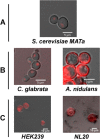Cell penetrating peptides and cationic antibacterial peptides: two sides of the same coin
- PMID: 24706763
- PMCID: PMC4031501
- DOI: 10.1074/jbc.M113.515023
Cell penetrating peptides and cationic antibacterial peptides: two sides of the same coin
Abstract
Cell penetrating peptides (CPP) and cationic antibacterial peptides (CAP) have similar physicochemical properties and yet it is not understood how such similar peptides display different activities. To address this question, we used Iztli peptide 1 (IP-1) because it has both CPP and CAP activities. Combining experimental and computational modeling of the internalization of IP-1, we show it is not internalized by receptor-mediated endocytosis, yet it permeates into many different cell types, including fungi and human cells. We also show that IP-1 makes pores in the presence of high electrical potential at the membrane, such as those found in bacteria and mitochondria. These results provide the basis to understand the functional redundancy of CPPs and CAPs.
Keywords: Antimicrobial Peptides; Cell-penetrating Peptides; Computational Biology; Membrane Biophysics; Receptor Endocytosis.
© 2014 by The American Society for Biochemistry and Molecular Biology, Inc.
Figures







Similar articles
-
Cell-penetrating antimicrobial peptides - prospectives for targeting intracellular infections.Pharm Res. 2015 May;32(5):1546-56. doi: 10.1007/s11095-014-1550-9. Epub 2015 Mar 17. Pharm Res. 2015. PMID: 25777610
-
Multistep optimization of a cell-penetrating peptide towards its antimicrobial activity.Biochem J. 2021 Jan 15;478(1):63-78. doi: 10.1042/BCJ20200698. Biochem J. 2021. PMID: 33313751
-
Improved antibacterial activity of a marine peptide-N2 against intracellular Salmonella typhimurium by conjugating with cell-penetrating peptides-bLFcin6/Tat11.Eur J Med Chem. 2018 Feb 10;145:263-272. doi: 10.1016/j.ejmech.2017.12.066. Epub 2017 Dec 29. Eur J Med Chem. 2018. PMID: 29329001
-
Cationic membrane peptides: atomic-level insight of structure-activity relationships from solid-state NMR.Amino Acids. 2013 Mar;44(3):821-33. doi: 10.1007/s00726-012-1421-9. Epub 2012 Oct 30. Amino Acids. 2013. PMID: 23108593 Free PMC article. Review.
-
Antimicrobial and cell-penetrating peptides: structure, assembly and mechanisms of membrane lysis via atomistic and coarse-grained molecular dynamics simulations.Protein Pept Lett. 2010 Nov;17(11):1313-27. doi: 10.2174/0929866511009011313. Protein Pept Lett. 2010. PMID: 20673230 Review.
Cited by
-
Membrane Active Peptides and Their Biophysical Characterization.Biomolecules. 2018 Aug 22;8(3):77. doi: 10.3390/biom8030077. Biomolecules. 2018. PMID: 30135402 Free PMC article. Review.
-
Effective Design of Multifunctional Peptides by Combining Compatible Functions.PLoS Comput Biol. 2016 Apr 20;12(4):e1004786. doi: 10.1371/journal.pcbi.1004786. eCollection 2016 Apr. PLoS Comput Biol. 2016. PMID: 27096600 Free PMC article.
-
Antitumor and antibacterial properties of virally encoded cationic sequences.Biologics. 2019 Jun 25;13:117-126. doi: 10.2147/BTT.S201287. eCollection 2019. Biologics. 2019. PMID: 31417238 Free PMC article.
-
Whole-Genome Approach to Understanding the Mechanism of Action of a Histatin 5-Derived Peptide.Antimicrob Agents Chemother. 2020 Feb 21;64(3):e01698-19. doi: 10.1128/AAC.01698-19. Print 2020 Feb 21. Antimicrob Agents Chemother. 2020. PMID: 31843998 Free PMC article.
-
Protein-stabilizing and cell-penetrating properties of α-helix domain of 30Kc19 protein.Biotechnol J. 2016 Nov;11(11):1443-1451. doi: 10.1002/biot.201600040. Epub 2016 Aug 12. Biotechnol J. 2016. PMID: 27440394 Free PMC article.
References
-
- Ellerby H. M., Bredesen D. E., Fujimura S., John V. (2008) Hunter-killer peptide (HKP) for targeted therapy. J. Med. Chem. 51, 5887–5892 - PubMed
-
- Kolonin M. G., Saha P. K., Chan L., Pasqualini R., Arap W. (2004) Reversal of obesity by targeted ablation of adipose tissue. Nat. Med. 10, 625–632 - PubMed
-
- Ellerby H. M., Arap W., Ellerby L. M., Kain R., Andrusiak R., Rio G. D., Krajewski S., Lombardo C. R., Rao R., Ruoslahti E., Bredesen D. E., Pasqualini R. (1999) Anti-cancer activity of targeted pro-apoptotic peptides. Nat. Med. 5, 1032–1038 - PubMed
-
- Vives E. (2005) Present and future of cell-penetrating peptide mediated delivery systems: “is the Trojan horse too wild to go only to Troy?” J. Control Release 109, 77–85 - PubMed
Publication types
MeSH terms
Substances
LinkOut - more resources
Full Text Sources
Other Literature Sources
Medical
Molecular Biology Databases
Miscellaneous

